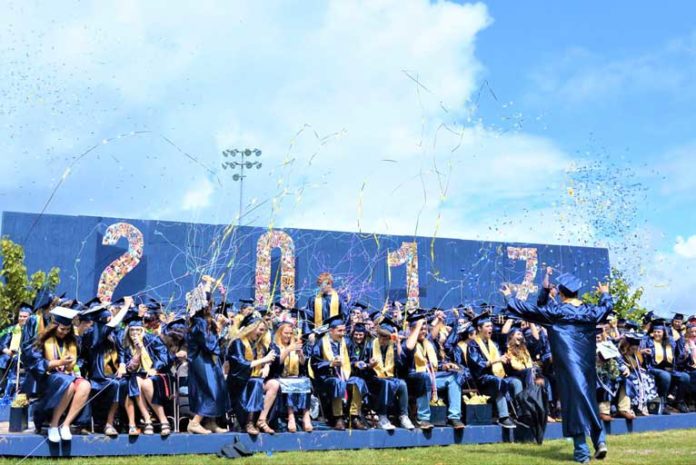The official graduation rate for Brookings-Harbor High School Class of 2017, released by the Oregon Department of Education on Thursday, Jan. 25, 2018 is 76.98 percent, compared to the statewide rate of 76.65 percent.
This marks another major step toward the district goal that “Every Student Can Succeed” with an improvement over last year’s rate of 70.50% and from the previous seven years when the graduation rate languished in the low 60s and high 50s percentage-wise for students finishing high school in four years.
It is the first time since the state began tracking the graduation rate in its current form in 2008-09, that Brookings-Harbor School District has surpassed the statewide average.
The graduation rate tracks students beginning in ninth grade and measures how many of those students graduate within four years. The rate is adjusted for students moving in or out of the district.
The district’s five-year cohort “completer” rate decreased slightly to 75.54 percent, while the statewide rate is 83.22 percent. Completers are students who earned a regular or modified diploma (as well as those who earned an extended diploma, adult high school diploma, or GED) within five years.
According to Brookings-Harbor High School Principal Lisa Dion, the school district has made strides in the past three and a half years toward establishing a graduation culture that starts in elementary school, keeps students on-track along the way in middle school, and focuses on immediate interventions for at-risk students in high school.
The 2016-17 freshman-on-track rate was 91.8 percent, and is a good indicator of continued graduation rate improvements in the coming years. In 2013-14 the freshman-on-track rate was just 59.3 percent.
“We’ve realized that the best thing we can do is to make sure that all students pass classes the first time. Our staff gets together and looks at ‘at-risk’ data,” she said. “We work in small groups to come up with interventions to help the student. For example, they might go to the extended school day to get help or peer tutoring, they might be encouraged to work one-on-one with a teacher during their office hours.”
Starting next fall, BHHS plans to offer its extended school day program three days per week, adding a day to the two days per week that it is currently available. The high school is hiring a new coordinator for the program to continue to grow and improve efforts to track student progress and get parents involved in success strategies.
“With the progress we’ve made over the last three years in our freshman-on-track and graduation rate, new issues will continue to arise that need to be addressed,” said BHHS Principal Lisa Dion. “From my seat, I feel that there is a ton of work still to do.”
Across the state, students who participate in Career Technical Education (CTE) classes have a higher graduation success rate than their peers, underscoring the importance and impact of the Brookings-Harbor School District’s current investments in growing and improving its CTE program and career pathway opportunities. This includes joint investments in vocational training classes such as welding with Southwestern Oregon Community College. Mirroring this statewide trend, the 2016-17 four-year graduation rate for BHHS students who participated in CTE classes was 93.02 percent.
“We are now at a ‘new normal,’ which gives us a starting point for continued innovation,” said District Superintendent Sean Gallagher. “Our work is to continue to address the question, What will it take to make the next leap past an 80% four-year graduation rate, then a 90% four-year graduation rate? I believe that we are capable of getting there and giving all students the best possible chance for success in school and life.”
Four-Year Graduation Rate Data for Brookings-Harbor School District:
This year’s graduation rate is an increase from last year and continues an upward trend.
2016-17 76.98% (76.65% statewide)
2015-16 70.50% (74.8% statewide)
2014-15 62.20% (73.8% statewide)
2013-14 63.64% (72.0% statewide)
2012-13 61.33% (68.7% statewide)
2011-12 57.42% (68.4% statewide)
2010-11 63.03% (67.7% statewide)
2009-10 65.31% (66.4% statewide)
2008-09 65.60% (66.2% statewide)
Please Like, Share and Follow the …


















